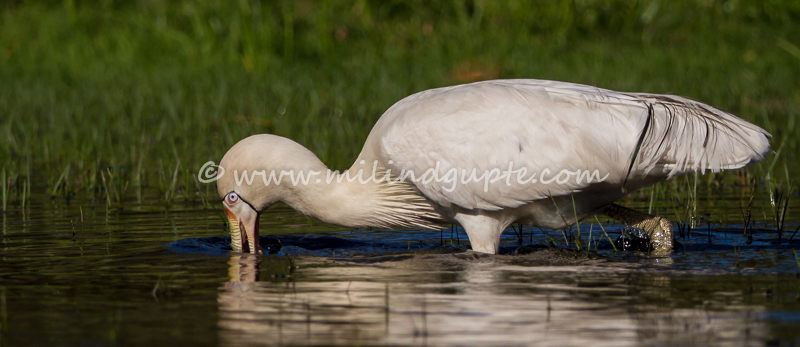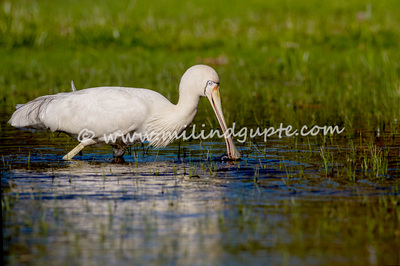|
It's hardly rocket science, but the best way to photograph bird & wildlife is to be out there in the nature where the birds and animals are. Sitting at home admiring your gear does not get you the shots you are after.
To put preaching into practice, whenever I have some spare time on my hands, nothing else planned and the weather is not inclement I grab my gear and head out even, if it is to something as non exotic as one of the local water bodies or reserves. You will be surprised at the opportunities that present themselves by just being out there. I have been pleasantly surprised many times and that was just due to me getting off my backside and being out there. One such afternoon I headed out to a water body close by to see what was around. I made myself comfortable on the grass with the gear handy, just soaking in the atmosphere. It was warm & tranquil under the clear blue sky. A few sacred ibises were flying overhead, a pelican was soaring high on the thermals. Dusky swamp hens were going about their business along the waters edge & a lone pied cormorant was drying it’s out-stretched wings on a dead tree in the distance. Lorikeets and other birds could be heard amongst the trees. I was happy just lazing there and watching the world go by. There was just not enough inducement for me to grab the gear and start shooting. I must have been sitting there for the better part of an hour when out of the corner of my eye I saw a white bird flying low heading in my direction. Engrossed in watching the antics of the swamp hens and masked lapwings I did not pay much attention thinking it was just another ibis. The bird glided down and landed in the shallow water in front of me. It wasn't just another ibis but a yellow billed spoonbill that I was looking at. Now here was an opportunity that had presented itself and now it was up to me to make the most of it. It glanced around and immediately commenced feeding in the shallows sweeping its bill from side to side in true spoonbill fashion. The Yellow billed Spoonbill [Platalea flavipes] is usually more solitary than the other species Royal Spoonbill found in Australia. It is found throughout the country except the dry deserts. It gets its name from the colour of its spoon shaped bill which is yellow whereas the Royal Spoonbills is black [Please see photos below & also birds gallery for comparison - Royal spoonbill not shot with Canon 200-400 f4]. Its legs are also yellow. In breeding plumage, there is a thin black line separating its face from the white head, it has black lacy feathers on its back and long feather hackles grow on its chest. The body is dirty white or creamy in colour and not white like the Royal Spoonbills. I watched for a while and once it had settled into feeding, I grabbed the Canon 200-400 f4 & 7D which was on the picnic blanket by my side and mounted it on the monopod. I like to photograph birds at their eye level so there was no need to extend the collapsed monopod, the height was just right for shooting. Having checked the settings, I cautiously butt crawled at an angle towards the spoonbill who was fully engrossed in feeding. As I edged closer to the bird and the water, the grass grew thicker & I could feel water slowly seeping through my trouser bottom. The grass closer to the edge clearly held a lot of water. Through the Canon 200-400 f4 I could clearly make out the feather detail of the bird, the black plumes towards it’s tail & the pale bluish eyes and also the markings on its beak. The spoonbill would go from left to right probing the bottom and coming up from time to time with a beak full and then it would walk back from right to left again repeating the process. With a quick glance at the histogram & keeping a lookout for blinkies I kept shooting. I am now getting used to the Canon 200-400 f4 now and the results are getting better. Cannot fault the colours, IQ or the sharpness. It snaps into focus [It would surely focus better with a body having the latest autofocus module]. The spoonbill kept feeding for a while before deciding that there was a better feeding spot on the other side of the water body. I had got my shots, the spoonbill had made my day. Putting the theory, of getting out where the birds were likely to be, into practice had worked as it had many times before. My pant seat was now thoroughly wet. A wet bottom was but a small price to pay for lovely photos of the spoonbill.
1 Comment
VAIBHAV Gadkari
12/8/2013 08:41:56 am
Simply great
Reply
Leave a Reply. |
Archives
October 2017
Categories
All
|






 RSS Feed
RSS Feed
